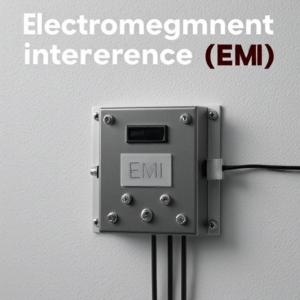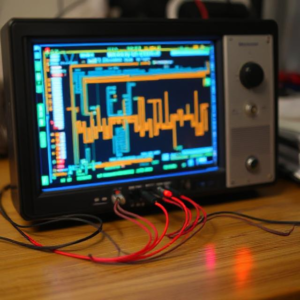Electromagnetic Interference (EMI) and Shielding: An Easy Explanation
1. What is Electromagnetic Interference (EMI)?
Electromagnetic Interference (EMI) happens when unwanted electromagnetic waves (or signals) disrupt the normal operation of electronic devices or systems. These disturbances can cause malfunctions, errors, or even complete failure in devices like phones, radios, computers, and medical equipment.
You can think of EMI as “noise” or “static” that messes with your device’s ability to perform correctly.

2. How Does EMI Happen?
Every electronic device produces electromagnetic waves (signals) while working. These waves can interfere with the operation of nearby devices if they are not properly managed. EMI can occur in two main ways:
- Radiated EMI: This type of interference occurs when electromagnetic waves travel through the air. For example, if a computer emits electromagnetic waves, it might interfere with nearby radio signals, causing static or distortion.
- Conducted EMI: This happens when unwanted electromagnetic signals travel through cables or wires. For example, if a power supply emits interference, it could travel through power lines into other devices, causing problems.
3. What Causes EMI?
EMI can be caused by a variety of factors, including:
- Electrical Devices: Any device that uses electricity, such as a phone, microwave oven, or motor, can emit electromagnetic waves.
- Power Lines: High-voltage power lines can produce electromagnetic fields that interfere with nearby electronics.
- Radio Frequency (RF) Signals: Devices like radios, TV transmitters, and cell phones emit RF waves that can interfere with other devices.
- Switching Power Supplies: Devices that change power levels (like chargers and adapters) can create high-frequency noise that spreads through the environment.
4. How Does EMI Affect Devices?
EMI can lead to various issues, including:
- Static or Distortion: If you’ve ever heard static on a radio or experienced poor image quality on a TV due to nearby devices, that’s caused by EMI.
- Data Loss or Errors: Devices like computers and smartphones rely on precise data transmission. EMI can cause data to be lost or corrupt, leading to errors or crashes.
- Reduced Performance: Devices may work slower or behave unpredictably when exposed to interference from nearby electronics.
- Complete Malfunction: In severe cases, EMI can cause a device to completely stop working or even be permanently damaged.
5. What is EMI Shielding?
EMI Shielding is a technique used to protect devices from electromagnetic interference. Shielding works by creating a barrier that prevents electromagnetic waves from entering or exiting a device.
You can think of it as a “protective coat” that blocks the interference, ensuring that your device works without disruption.
6. How Does EMI Shielding Work?
EMI shielding works by using materials that block or absorb electromagnetic waves. These materials can either reflect the waves away from the device or absorb them to stop them from interfering with sensitive components.
Common shielding methods include:
- Conductive Materials: Materials like copper, aluminum, or steel are used because they can reflect and absorb electromagnetic waves.
- Metal Mesh: A fine metal mesh is often used in devices like smartphones to protect internal components while allowing some airflow.
- Conductive Coatings: Some devices are coated with a conductive paint or material that blocks EMI.
- Faraday Cages: This is an enclosure made from conductive materials that can completely block external electromagnetic waves from entering. It’s like placing your device inside a shielded box.
7. Types of EMI Shielding Materials
- Metals: Metals like copper, aluminum, and steel are commonly used in shielding because they are good conductors of electricity and can block electromagnetic waves.
- Conductive Plastics: These are plastics that are mixed with conductive materials (like carbon fibers or metals) and are used when flexibility or light weight is required.
- Conductive Fabrics: These are fabrics made from fibers that have conductive coatings. They are flexible and can be used for clothing or flexible electronic devices.
- Foams: Special foams coated with conductive materials can be used in some applications to absorb EMI.
8. Where is EMI Shielding Used?
EMI shielding is used in many areas, including:
- Consumer Electronics: Devices like smartphones, laptops, and TVs use shielding to ensure they work properly without interference from other electronics.
- Medical Equipment: Medical devices, such as MRI machines and pacemakers, need to be shielded to prevent EMI from affecting their delicate sensors or operations.
- Automotive: Modern cars are full of electronics, from infotainment systems to advanced safety features. EMI shielding ensures that these systems function without interference from each other.
- Military and Aerospace: In sensitive equipment like radar systems or communication devices, EMI shielding ensures safe, reliable operation in environments with high electromagnetic noise.
- Telecommunication: Cell towers and satellite equipment use shielding to prevent interference between devices operating at different frequencies.
9. How to Reduce EMI Without Shielding?
While shielding is a great way to prevent EMI, there are other techniques to reduce interference:
- Proper Grounding: Connecting electrical equipment to the ground helps prevent interference from spreading.
- Using Filters: EMI filters can be added to power lines or signal paths to block unwanted frequencies.
- Careful Layout of Circuits: When designing electronics, engineers place components in specific ways to minimize EMI.
Conclusion
Electromagnetic Interference (EMI) is like unwanted “noise” that can disrupt the operation of electronic devices. EMI shielding is the technique used to block or absorb this noise to ensure that devices work smoothly and without interference. By using materials like metals or conductive plastics, shielding helps protect sensitive electronics in various applications, from smartphones to medical devices. Whether you’re protecting your home electronics or designing sophisticated machinery, shielding is a crucial part of modern electronics.











